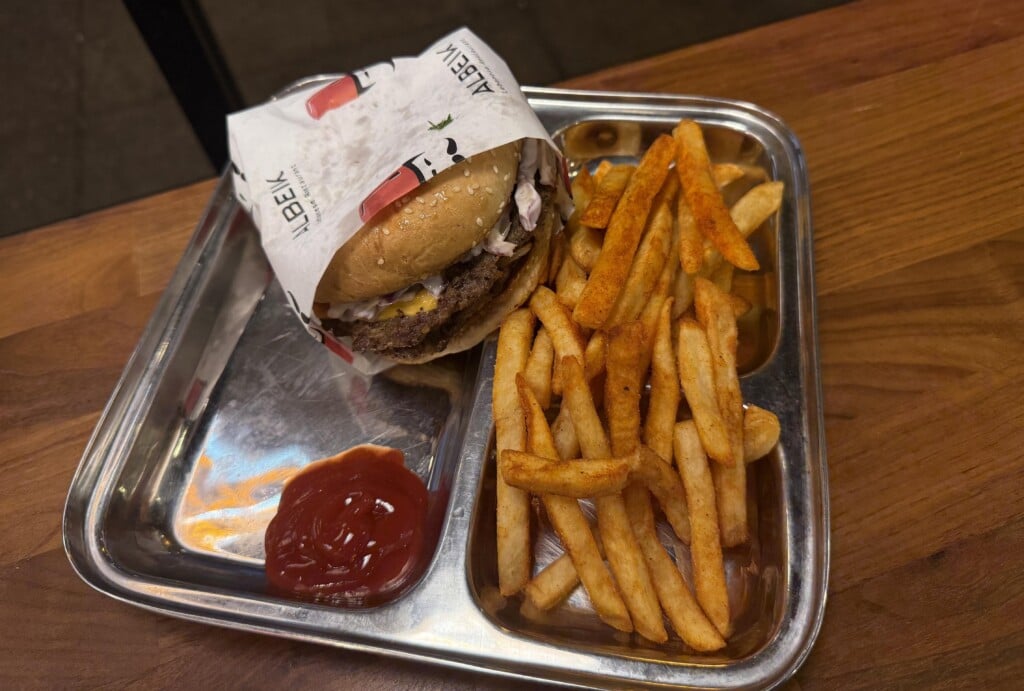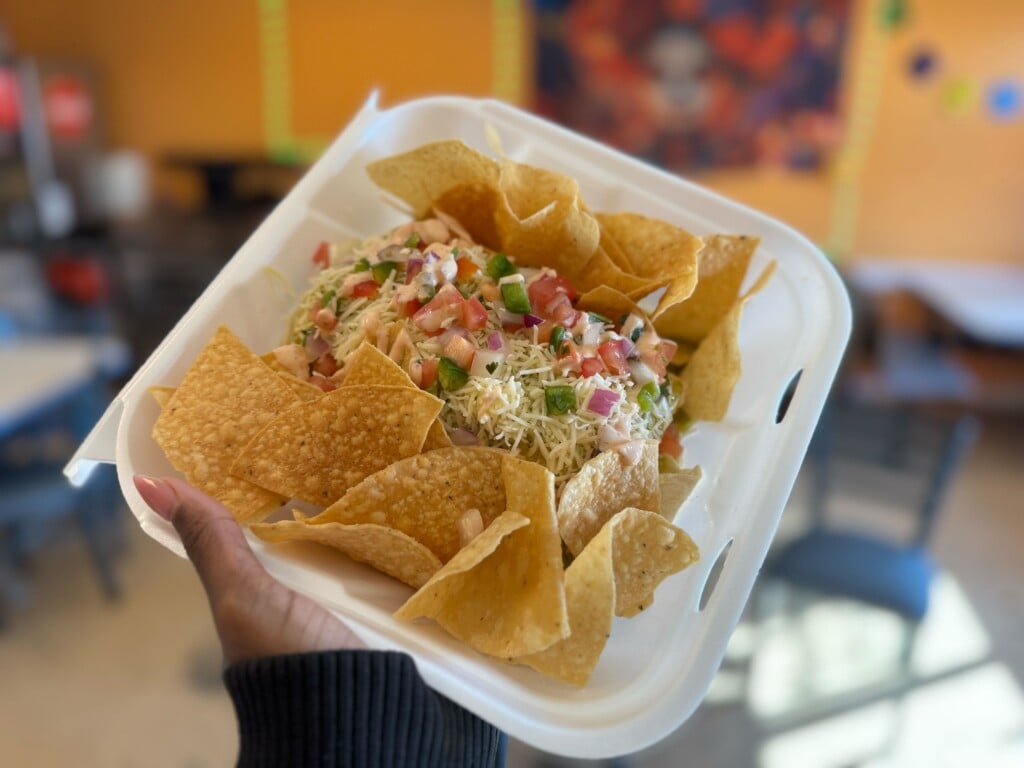Trays of Our Lives
Last week, I groggily poured myself a cup of coffee at 7 in the morning and flipped on the tube to watch the news, but Turner Classic Movies came on instead. It was way too early for me to appreciate the languid beauty of 1930s movie star Loretta Young, but the title of the film was somewhat provocative — Week-end Marriage — and before I knew it, I was sucked into the ridiculous plot. The film’s story is stupid — Young nearly ruins her marriage by getting a better job than her sexy, shiftless husband — but one scene in particular fascinated me.
At one point, Young and her man dine in a cafeteria. A Hollywood version, mind you, but I’m guessing it came somewhat close to what a nice ’30s cafeteria might have looked like. The patrons slid round black-lacquered trays (they’d be pretty stylish today) down a polished marble bar and shouted out orders — “Give me some of those potatoes, will ya?” — to the employees behind the line, all females tidily dressed in starched aprons and little white caps. No glass sneeze guards, of course — this was the prehygienic era.
As I sipped my coffee, I lost interest in the film but started thinking about cafeterias. I grew up loving them, probably because my parents, who were children of the Great Depression, loved them.
Back in the hot summer of 1932, when Week-end Marriage opened at the Liberty Theatre at 11th Street and Main, hungry moviegoers leaving that building could take their pick of six cafeterias within a few short blocks. The wildly popular Forum Cafeteria at 1220 Main was the creation of self-made millionaire Clarence Hayman (who started his career as William Rockhill Nelson’s stable boy). The Forum not only served thousands of meals every day from 6 a.m. to 9 p.m. but also advertised that it offered “33,000 cubic feet of washed pure air per minute.” If the 27-cent T-bone steak wasn’t alluring enough, the air conditioning certainly was.
Although the Forum Cafeteria on Main closed in the 1970s, long before I moved to Kansas City, almost everyone I know who is old enough to have dined there recalls it fondly. My friend Jeanne says that going to the restaurant — even in its waning years, during the late 1960s — was a big thing. “It was downtown,” she says. “And the food was delicious.”
My friend Addison ate at the Forum several times in 1973 and recalls it as something out of a film noir: “It was slightly grungy by that point. In those days, 12th Street still had a wild nightclub scene, so the neighborhood had this aura of corruption. And there was a tawdry element to the cafeteria, too.”
That makes me wish the Forum could have hung around long enough to be incorporated into the Power and Light District as a fabulous relic of a very different urban Kansas City. Despite a marketing campaign that encourages visitors to leave their inhibitions in the minivan, the shiny new mix of restaurants could use a pinch of real tawdry.
It’s sad to think that the day of the cafeteria seems to be over. By 1963, there were only six left in the metropolitan area, including the Forum, the Myron Green Cafeteria and the Charl-Mont downtown. The last glamorous cafeteria, if you could call it that, was Putsch’s Cafeteria on the Country Club Plaza (where Houston’s resides today).
A vintage color postcard of Putsch’s from the 1960s shows its curvy orange leatherette sofa and the visually sumptuous array of food on the line. Yes, cafeterias were often as inexpensive as greasy diners, but the sensory overload of the meal made it feel like so much more. There was the tactile experience of loading up a plastic tray while quietly sliding it over metal tubing. And the visual thrill of the beckoning, jewel-like Jell-O cubes, the artfully arranged little salads, the mounds of golden fried chicken or thick chopped steaks floating in thick brown gravy — and the beautiful desserts! Then there were the tough decisions that had to be made: chicken potpie or pork cutlet? Mashed potatoes or broccoli rice casserole?
[page]
All of this might sound like a standard buffet, but there’s a big difference. Buffets, which have essentially replaced cafeterias, seem like a better deal. After all, you don’t have to make a choice among entrées at an all-you-can-eat buffet — just pile on all the entrées. At a buffet, you can stuff yourself until you explode; cafeterias are less about gluttony and more about well-balanced, old-fashioned home cooking. These days, though, cafeterias evoke school lunchrooms and hospital dining rooms.
No wonder young diners dismiss them as antiques. They are! Modern cafeterias — if you can find one — serve pretty much the same fare they’ve been dishing up since Herbert Hoover was in the White House: chicken and noodles, fried chicken, fried fish, chopped steak, oddball salads (including Jell-O, of course), layer cakes and pies. The slice of cherry pie that cost 8 cents at the Forum in 1932 is $1.99 today at the Piccadilly Cafeteria in Overland Park. But the Louisiana-based Piccadilly chain, which has outlasted all of its corporate rivals in the suburbs (Texas-based Furr’s, Wyatt’s and Luby’s cafeterias all came in the 1980s and left), still serves a great cherry pie — and the best liver and onions in town.
I don’t have many friends who’ll go with me to eat at the Piccadilly Cafeteria. The exterior of the building, a drab gray concrete block, looks like a military bunker. But the interior is over the top — which is exactly the reason I like it. The dining room is as loud as a used-car salesman: plaid wallpaper, plaid carpeting and light fixtures made from big clumps of plastic grapes — the kind that looked so groovy on 1960s coffee tables.
And surprisingly, not everyone who eats there can remember the Depression. Yes, I saw a few patrons with walkers, but there were just as many young families led by fathers barking out the same stern command that my old man did when I was a kid: “Five items only, and that includes dessert and a drink!”
Fortunately for those dads, it’s easy to be budget-conscious here. The $5.99 “Dilly Meal” includes a main dish entrée, two side dishes and bread (the yeast rolls are great, but don’t bother with the garlic toast). That’s about the same as a fast-food value meal. On the night I dined with Frank, Bob and Addison, we loaded up our trays as if we hadn’t eaten for weeks, and the bill for all four of us was $44. The puck-sized salmon croquette, like the chicken-fried steak, was breaded in crushed saltines and deep-fried for a hardy crunch, and the fried chicken was juicy and good. The side dishes were Southern, honey, so I called out for a little dish of fried okra, some macaroni and cheese and a big ol’ scoop of cheesy rice casserole. I was gettin’ Dilly, all right.
“Why are the desserts covered in plastic wrap?” Frank griped.
“To keep ’em fresh, sugar,” I said, reaching past him for a chocolate-and-whipped-cream confection called “Italian Delight Cake.” I don’t know what made it Italian but I was delighted enough.
[page]
Piccadilly’s may be a retro dining experience, but it’s nothing like the time warp at the legendary Jerre Anne Cafeteria & Bakery
in beautiful downtown St. Joseph.
Named for the founder’s two daughters, the 78-year-old Jerre Anne’s is two years older than Week-end Marriage — as I pushed my tray down the line one recent Saturday afternoon, I half expected to see Loretta Young eating gooseberry pie in the amazing dining room. The restaurant is located in a white-shingled house with aluminum awnings over the windows, and the eating area looks like … a residential dining room, with dainty floral wallpaper on the walls and the chairs upholstered in bright turquoise leatherette.
Unlike the bounty at the Piccadilly, this cafeteria line isn’t particularly long, and the selection isn’t so great. But the fact that it still exists is reason enough to pull off Interstate 29 the next time you’re headed to Omaha — or to make the 45-minute drive just for the hell of it.
Jerre Anne’s started in 1930 as a delicatessen operated by two sisters, Afra Lineberry and Frances Carolus. The restaurant’s Web site says the women started out by selling cold refreshments to the trolley driver and his passengers who stopped on the route out of town, and they turned it into a cafeteria in the 1940s.
On my most recent visit, I brought my friend Patrick, who had grown up in St. Joseph. His mother had worked at Jerre Anne’s when she was young, but he’d never eaten in the cafeteria before. “It was too expensive for a big family,” he explained.
He was amused by the restaurant’s eccentricities — gooey cinnamon butterfly rolls wrapped in wax paper; carrot salad made with marshmallows; and a chicken-and-biscuits lunch, which was more like a brothy chicken soup than a stew.
At Jerre Anne’s, you have to appreciate the fact that the food is homemade — like some meals one makes at home, certain dishes are better than others. My beef stroganoff was made with hamburger and elbow macaroni and tasted a lot like Hamburger Helper, which evoked a completely unexpected twinge of nostalgia for me. And not a good one. Similarly, my side dish of scalloped eggplant was a fluffy spoonful of eggy soufflé that reminded me of one of my own madcap culinary experiments with vegetables. Fun, but never to be repeated.
Desserts were quaint, old-fashioned items such as baked custard and apple pie swimming in butter sauce. The cherry pie needed more cherries (it was like a cherry-jam pie), but the coconut-cream pie was fabulous, with a terrific crust.
“At a buffet,” Patrick said as we drove out of town, “you can eat all you want, and the food is just about the same. Why go to a cafeteria?”
Which, sadly, told me everything I needed to know about why so few of them remain.




